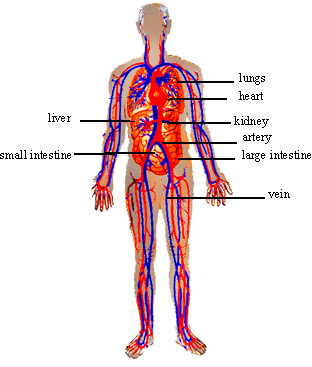The transport system of an animal moves substances
to where they are needed in the body. Even the smallest animal must
have the means of transporting substances around its body. Oxygen
and food molecules must move to all the cells, and the waste products
must be removed from the cells and expelled into the environment.
A variety of fluid systems, called vascular systems, help
such transport in most members of the animal kingdom. A circulatory
system is a vascular system (i.e. with tubes or vessels) in
which the transport fluid moves rhythmically in a particular direction,
since it is propelled by a muscular pumping structure.

Figure 18.1
Unicellular organisms (Protozoa) have no specialized
system for circulation of fluid. Sponges and coelenterates also
lack a specialized circulatory system. Part of the evolution of
multicellular animals was the development of the body fluids
(tissue fluids, blood and lymph). These fluids provide all body
cells a stable and relatively non-fluctuating environment, and fill
in the space between cells and cell layers.
The body fluids are divided into (a) intracellular
(inside the cells) and (b) extracellular, (blood plasma
and interstitial fluid). The blood plasma is present in blood vessels
and the interstitial fluid in the spaces around the cells. Nutrients
and gases passing between blood vessels and cells have to cross
this fluid.